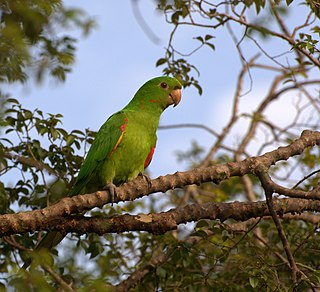
Macaws are a group of New World parrots that are long-tailed and often colorful. They are popular in aviculture or as companion parrots, although there are conservation concerns about several species in the wild.

The scarlet macaw is a large yellow, red and blue Neotropical parrot native to humid evergreen forests of the Americas. Its range extends from southeastern Mexico to Peru, Ecuador, Colombia, Bolivia, Venezuela and Brazil in lowlands of 500 m (1,600 ft) up to 1,000 m (3,300 ft), the Caribbean island of Trinidad, as well as the Pacific island of Coiba. Formerly, the northern extent of its range included southern Tamaulipas. In some areas, it has suffered local extinction because of habitat destruction, or capture for the parrot trade, but in other areas, it remains fairly common. It is the national bird of Honduras. Like its relative the blue-and-yellow macaw, the scarlet macaw is a popular bird in aviculture as a result of its striking plumage.

Parrotlets are a group of the smallest New World parrot species, comprising several genera, namely Forpus, Nannopsittaca, and Touit. They have stocky builds and short tails and are endemic to Middle and South America. They resemble the lovebirds of Africa in size, body shape and behaviour and have sometimes been referred to as "South American lovebirds", but are not closely related.

Caique refers to a group of four species of parrots in the genus Pionites endemic to the Amazon Basin in South America.

Geophagia, also known as geophagy, is the intentional practice of eating earth or soil-like substances such as clay, chalk, or termite mounds. It is a behavioural adaptation that occurs in many non-human animals and has been documented in more than 100 primate species. Geophagy in non-human primates is primarily used for protection from parasites, to provide mineral supplements and to help metabolize toxic compounds from leaves. Geophagy also occurs in humans and is most commonly reported among children and pregnant women.

The green-rumped parrotlet, also known as the green-rumped parakeet, is a species of parrot in the family Psittacidae that is found in northeastern South America and the Caribbean island of Trinidad. The green-rumped parrotlet occurs from northern Venezuela eastwards to the lower Amazon in Brazil, Also Suriname and has been introduced to Curaçao, Jamaica and Barbados. It prefers semi-open lowland areas and is also sometimes present in city parks. There are five subspecies.

The white-eyed parakeet, known in aviculture as white-eyed conure, is a species of bird in the subfamily Arinae of the family Psittacidae, the African and New World parrots. It is found in every mainland South American country except Chile and also on Trinidad.

The dusky-headed parakeet, also known as Weddell's conure or dusky-headed conure in aviculture, is a small green Neotropical parrot with dusty grey head found in wooded habitats in the western Amazon basin of South America. Its range extends from southeastern Colombia south through eastern Ecuador, eastern Peru, and southwest Amazonian Brazil, to central Bolivia. It prefers semiopen habitats such as várzea, forest edge, and forest remnants, but can also be found in coffee plantations. It is generally common and its habitat preference makes it less vulnerable than many other Amazonian species. Consequently, it is considered to be of least concern by BirdLife International and IUCN.

The Andean parakeet is a species of bird in subfamily Arinae of the family Psittacidae, the African and New World parrots. It is found in Argentina, Bolivia, and Peru.

The cobalt-rumped parrotlet or blue-winged parrotlet is a species of parrot in the family Psittacidae.

The cobalt-winged parakeet is a species of bird in subfamily Arinae of the family Psittacidae, the African and New World parrots. It is found in Bolivia, Brazil, Colombia, Ecuador, Guyana, Peru, and Venezuela.

Forpus is a genus of neotropical parrots in the family Psittacidae. It is the only genus in the Forpini tribe of the subfamily Arinae.

The black-headed parrot is a species of bird in subfamily Arinae of the family Psittacidae, the African and New World parrots. Other colloquial names are black-crowned parrot, black-capped parrot, black-headed caique, and for subspecies P. m. pallidus, pallid caique. It is found in Brazil, Colombia, Ecuador, French Guiana, Guyana, Peru, Suriname, and Venezuela.

The scarlet-shouldered parrotlet, also known as the red-winged parrotlet or Huet's parrotlet, is a species of bird in subfamily Arinae of the family Psittacidae, the African and New World parrots. It is found in Bolivia, Brazil, Colombia, Ecuador, Guyana, Peru, and Venezuela, possibly in Suriname, and as a vagrant to Trinidad and Tobago.

The sapphire-rumped parrotlet is a species of bird in subfamily Arinae of the family Psittacidae, the African and New World parrots. It is found in Brazil, Colombia, Ecuador, French Guiana, Guyana, Peru, Suriname, and Venezuela.

The rose-fronted parakeet, known as the rose-fronted conure in aviculture, is a species of bird in the subfamily Arinae of the family Psittacidae, the African and New World parrots. It is found in Bolivia, Brazil, Ecuador, and Peru.
Charles A Munn III is an American conservation biologist and ecotourism entrepreneur. Munn is the founder and owner of SouthWild, a conservation-based ecotourism company that offers photography safaris throughout South America. In 2013, Condé Nast Traveller listed him as one of worlds's three leading experts on wildlife tourism, and the only one for South America. From 1984-2000 he was a conservation field biologist with the Wildlife Conservation Society. He also founded Peru Verde Conservation Group, the BioBrasil Foundation, and Tropical Nature Conservation Group. Munn is an American citizen but spends most of his time in Brazil and Chile. He is based in the Mato Grosso state.
Bárbara D'Achille (1941-1989) was a Latvian-Peruvian journalist and conservationist. She was born in Latvia but spent most of her adult life in Western Europe and South America. She wrote for El Comercio, where she managed a regular ecology section. Brown describes her as Peru's foremost environmental journalist. She also consulted for the World Wildlife Fund and other international NGOs.


















